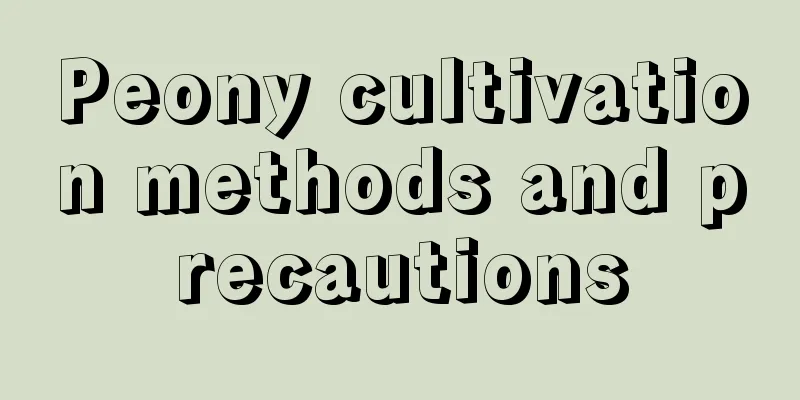Peony cultivation methods and precautions

1. SoilThe soil requirements for maintaining peonies are not high. Fertile sandy soil with good drainage is the best. You can also use leaf mold, original soil and river sand to mix to make nutrient soil. No matter what kind of soil you choose for cultivation, it must be disinfected. You can choose carbendazim for sterilization to reduce the occurrence of diseases and pests. 2. MoistureWhen the temperature rises in spring, peonies can be moved outdoors for cultivation. At this time, they should be watered thoroughly and the soil should be loosened, protecting the roots while loosening the soil. Especially in spring, when new buds sprout and before and after flowering, there must be sufficient water. In the dry north, you can water more, but not too much. Long-term accumulation of water will cause root rot. Do not water when the sun is too strong at noon in summer. It is best to water in the early morning and evening. You can add some fertilizer when watering before and after flowering, and use fertilizer and water to supplement nutrients to make the flowers bloom more vigorously. 3. FertilizationThe timing of fertilizing peonies is very important. Do not add fertilizer to new plants within half a year to avoid fertilizer damage. Fertilize again after half a year. Before the flowers bloom in spring, the temperature has just risen and the leaves begin to sprout. At this time, fertilize to accumulate nutrients for flowering; add fertilizer again after the flowers fade to replenish the nutrients consumed by flowering, and it can also help differentiate new flower buds; add fertilizer again before winter to prepare for overwintering. Generally, it is enough to apply this fertilizer three times a year, and the fertilizer should not be too concentrated. 4. Light and temperatureAdequate light is very beneficial to the growth of peony. Daily light can replenish nutrients, but strong light in summer and direct sunlight at noon should be avoided to prevent sunburn and excessive water loss. It can be maintained at normal room temperature, and the temperature should be controlled at around 25 degrees. Pay attention to ventilation before and after flowering to avoid high temperature stewing and affecting flowering. Move indoors in winter. |
<<: Orchid cultivation methods and precautions
>>: Lily cultivation methods and precautions
Recommend
How to grow Gardenia jasminoides well
Gardenia Growing Conditions When planting gardeni...
When is the best time to water asparagus fern? What kind of water is best for it to grow faster?
Watering time for asparagus fern There is general...
How to grow Guanyin bamboo well?
Guanyin bamboo , also known as rice bamboo and Pe...
Cabbage seed germination method
To germinate cabbage, first fill a basin with war...
How to keep succulents alive
Essential tools for farming Watering tool: droppe...
How to care for camellia leaves so that they grow bigger
1. Suitable soil Suitable soil is the basis of gr...
How to prevent and cure cyclamen curling and yellowing
Leaves curl and turn yellow Solution: Lack of nut...
When is the best time to harvest rice?
When rice is just harvested, the humidity is very...
These 4 kinds of flowers are the most "wasteful". They can eat up 5 kilograms of soil a year, and the fat ones are too fat to be kept!
If you grow a pot of spider plant, it can eat 5 k...
What is the difference between Chinese rose and rose?
1. Leaf Difference The rose on the market is a tr...
She doesn’t like growing flowers, but she likes growing melons and vegetables. Her vegetable garden is even more beautiful than yours!
These fruits and vegetables can climb the wall Ma...
How to grow Phalaenopsis to make it bloom more vigorously (How to grow Phalaenopsis at home)
The correct way for beginners to raise Phalaenops...
How to divide cymbidium orchids into pots and when and how to divide them into pots
The best time to divide cymbidium The best time t...
How to shape Yushu
1. Round crown shape The most common shape is to ...
Does Astilbe prefer sun or shade? Can it be exposed to the sun?
Does Astilbe prefer shade or sun? Astilbe has str...









